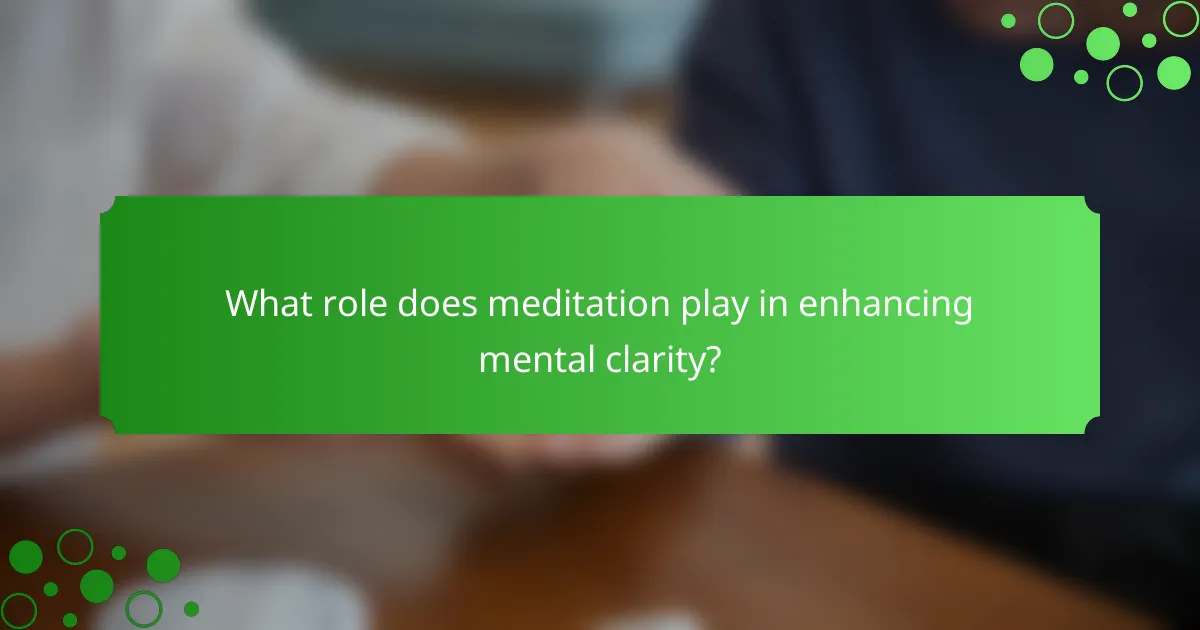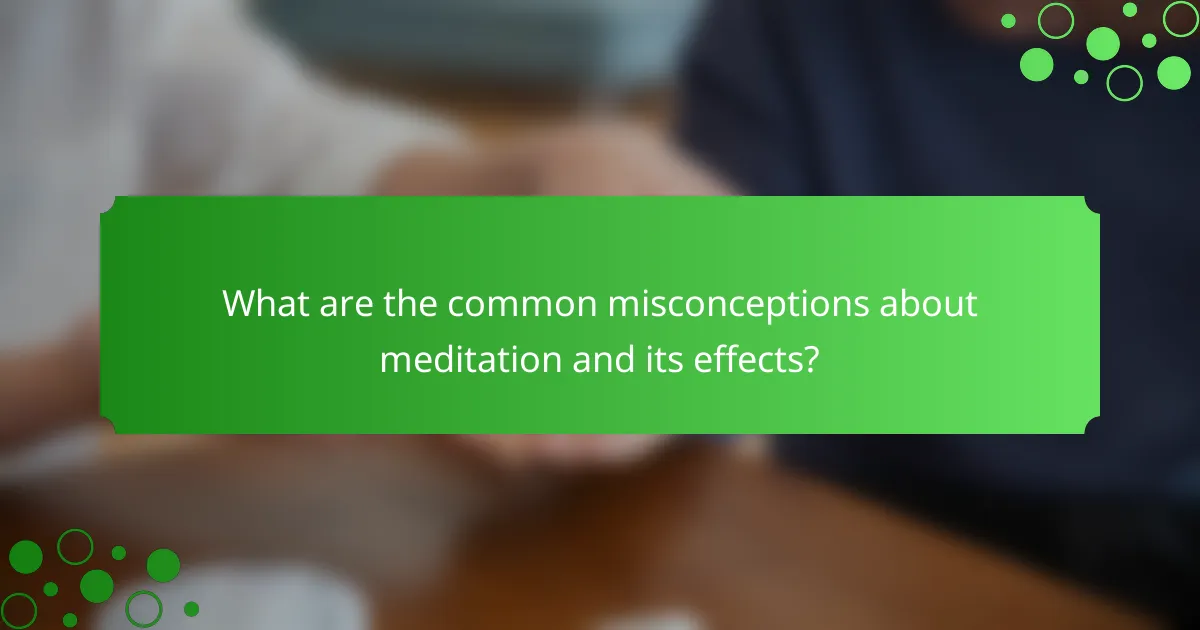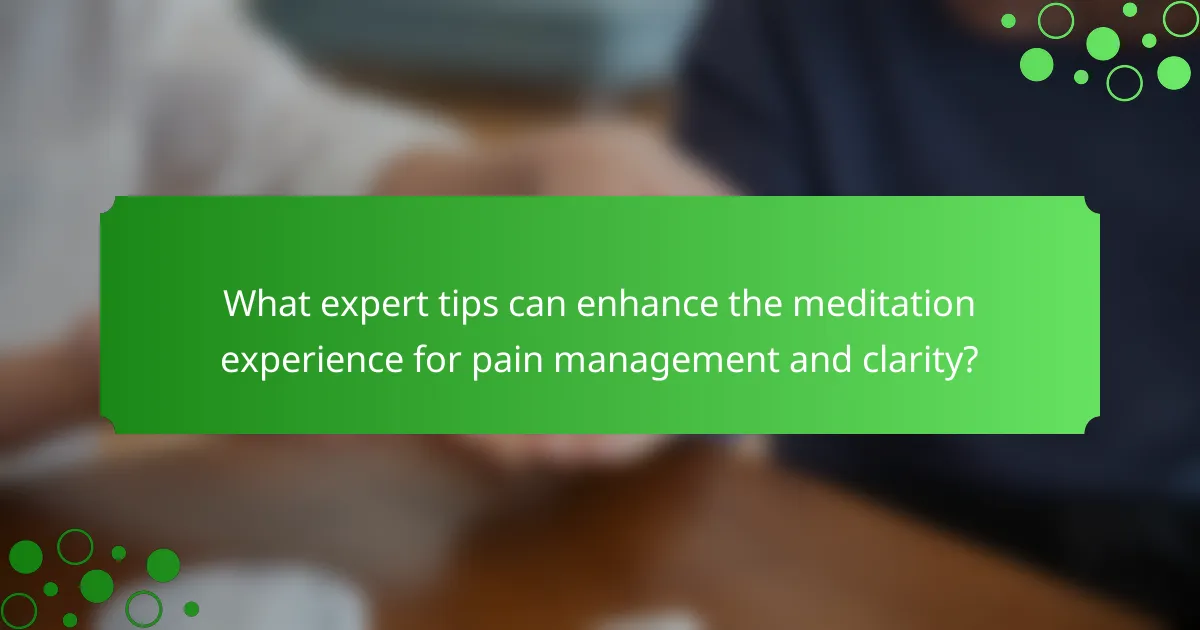Meditation offers significant benefits for managing chronic pain and enhancing mental clarity. It reduces stress, improves coping strategies, and fosters emotional resilience. Techniques such as mindfulness meditation and body scan exercises promote relaxation and focus. Regular practice can lead to better cognitive function and decision-making, making meditation a valuable tool for overall well-being.

How does meditation influence chronic pain management?
Meditation significantly enhances chronic pain management by reducing stress and improving mental clarity. Techniques such as mindfulness meditation, guided imagery, and body scan exercises focus attention away from pain, promoting relaxation. Research indicates that regular meditation practice can lower pain perception and improve coping strategies. Additionally, it fosters emotional resilience, leading to better overall well-being.
What are the physiological effects of meditation on pain perception?
Meditation significantly reduces pain perception by altering brain activity and enhancing emotional regulation. Research indicates that mindfulness meditation can decrease the intensity and unpleasantness of pain, promoting relaxation and mental clarity. Techniques such as focused attention and body scanning actively engage the mind, leading to decreased pain sensitivity. Regular practice fosters resilience against chronic pain, improving overall quality of life.
Which meditation techniques are most effective for pain relief?
Meditation techniques such as mindfulness meditation, guided imagery, and body scan are effective for pain relief. Mindfulness meditation helps individuals focus on the present, reducing the perception of pain. Guided imagery involves visualizing peaceful scenes, promoting relaxation and decreasing discomfort. Body scan meditation encourages awareness of bodily sensations, fostering a deeper connection to the body and alleviating pain. These techniques enhance mental clarity and emotional resilience, supporting overall well-being in chronic pain management.
How does meditation compare to traditional pain management methods?
Meditation offers a holistic approach to chronic pain management, enhancing mental clarity while contrasting with traditional methods. Unlike pharmaceuticals, meditation promotes self-regulation of pain through mindfulness and relaxation techniques. Research shows that consistent meditation practice can significantly reduce perceived pain levels, leading to improved quality of life. Additionally, meditation fosters mental clarity, enabling individuals to cope better with pain and stress. Techniques such as mindfulness meditation and guided imagery specifically target pain relief, showcasing unique attributes that differentiate them from conventional pain management methods.

What role does meditation play in enhancing mental clarity?
Meditation significantly enhances mental clarity by promoting focus and reducing distractions. Regular practice leads to improved cognitive function and emotional regulation. Studies show that mindfulness meditation can increase gray matter density in brain regions associated with memory and learning. This neuroplasticity supports clearer thinking and better decision-making. Techniques such as focused attention and body scan meditation are particularly effective in cultivating mental clarity.
How can meditation improve focus and cognitive function?
Meditation enhances focus and cognitive function by promoting mental clarity and reducing distractions. Regular practice can lead to improved attention span, better memory retention, and increased problem-solving abilities. Studies indicate that mindfulness meditation can lead to structural changes in the brain, particularly in areas related to attention and emotional regulation. As a result, individuals often experience heightened awareness and improved cognitive performance in daily tasks.
What are the long-term benefits of meditation for mental clarity?
Meditation significantly enhances mental clarity over the long term. Regular practice improves focus, reduces stress, and fosters emotional resilience. Research shows that individuals who meditate consistently experience better cognitive function and improved attention span. These benefits stem from meditation’s ability to alter brain structure and function, promoting a calmer and more organized thought process.

Which meditation techniques are best suited for beginners?
Mindfulness meditation, body scan, and loving-kindness meditation are ideal for beginners. These techniques enhance mental clarity and manage chronic pain effectively. Mindfulness meditation encourages present-moment awareness, while body scan promotes relaxation through focused attention on body sensations. Loving-kindness meditation fosters compassion and emotional well-being. Each technique requires minimal preparation and can be practiced anywhere, making them accessible for newcomers.
How do mindfulness and guided meditation differ in practice?
Mindfulness and guided meditation differ primarily in their approach. Mindfulness emphasizes present-moment awareness without specific guidance, while guided meditation involves following a facilitator’s instructions. Mindfulness can enhance chronic pain management by promoting acceptance and reducing stress, whereas guided meditation often provides structured techniques aimed at mental clarity and relaxation. Both practices can improve overall well-being, but their methods cater to different preferences and needs.
What are the most popular meditation apps available in 2025?
The most popular meditation apps in 2025 include Headspace, Calm, Insight Timer, and Ten Percent Happier. These apps enhance chronic pain management, improve mental clarity, and offer various techniques. Headspace focuses on mindfulness and guided sessions, while Calm emphasizes relaxation and sleep. Insight Timer provides a vast library of free resources, and Ten Percent Happier targets practical meditation for skeptics. Each app features unique attributes, such as personalized programs and community support, catering to diverse user needs.

How can meditation be integrated into daily routines for pain and clarity?
Meditation can be seamlessly integrated into daily routines to enhance pain management and mental clarity. Incorporating short meditation sessions, such as five to ten minutes in the morning or during breaks, can significantly reduce chronic pain and improve focus.
Establishing a consistent schedule reinforces the habit. Techniques like mindfulness meditation, body scans, and guided imagery can be particularly effective. Research shows that regular meditation practice can lower stress levels, which often contribute to pain perception, and enhance cognitive function.
Practicing meditation in quiet spaces or using apps for guidance can further support this integration. As a result, individuals may experience both physical relief and improved mental clarity over time.
What are some effective strategies for maintaining a consistent meditation practice?
To maintain a consistent meditation practice, establish a routine, set clear intentions, and create a conducive environment. Regular practice enhances chronic pain management and mental clarity.
1. Schedule sessions at the same time daily to build a habit.
2. Start with short sessions, gradually increasing duration to avoid overwhelm.
3. Use guided meditations or apps for structure and support.
4. Incorporate mindfulness throughout the day to reinforce practice.
5. Reflect on progress regularly to stay motivated.
How can one measure the effectiveness of meditation on pain and mental clarity?
Meditation effectively reduces chronic pain and enhances mental clarity. Key measurement methods include self-reported pain scales, mindfulness assessments, and brain imaging techniques. Research indicates that regular meditation practice can lead to significant reductions in pain perception and improvements in cognitive function. For example, a study found that participants experienced a 30% decrease in pain after eight weeks of meditation training.

What are the common misconceptions about meditation and its effects?
Many misconceptions exist about meditation’s effects on chronic pain management, mental clarity, and techniques. One common belief is that meditation is a quick fix for pain relief, while research shows it requires consistent practice to yield benefits. Another misconception is that meditation has no scientific backing; however, numerous studies confirm its positive impact on mental clarity and pain perception. Some people think meditation is solely about relaxation, overlooking techniques like mindfulness and focused attention that enhance cognitive function. Lastly, many believe meditation is only for spiritual purposes, ignoring its practical applications in stress reduction and emotional regulation.
How does cultural perception influence meditation practices around the world?
Cultural perception significantly shapes meditation practices worldwide, influencing techniques and benefits. In Eastern cultures, meditation often integrates spiritual elements, enhancing mental clarity and emotional balance. Western interpretations tend to focus on health benefits, such as chronic pain management and stress reduction. For example, mindfulness meditation is widely adopted in therapeutic settings in the West, emphasizing its practical applications. This cultural lens affects how individuals engage with meditation, leading to diverse practices tailored to specific societal values and needs.
What are the challenges faced by individuals new to meditation?
Individuals new to meditation often face challenges such as difficulty in maintaining focus, managing expectations, and overcoming discomfort. These hurdles can hinder the benefits of meditation for chronic pain management and mental clarity. Beginners may struggle with racing thoughts, leading to frustration. Additionally, some may find it hard to sit still for extended periods, which can create physical discomfort. Understanding these challenges can help individuals develop strategies to enhance their meditation practice and reap its full benefits.

What expert tips can enhance the meditation experience for pain management and clarity?
Expert tips to enhance meditation for pain management and clarity include focusing on breath awareness, setting a consistent schedule, and using guided imagery. These techniques can significantly improve mental clarity and reduce chronic pain perception. For instance, breath awareness helps anchor attention, while visualization can create a sense of calm. Incorporating mindfulness practices into daily routines fosters resilience against pain. Additionally, exploring different meditation styles, like body scan or loving-kindness, can tailor the experience to individual needs.
What common mistakes should be avoided when starting a meditation practice?
Common mistakes to avoid when starting a meditation practice include unrealistic expectations, neglecting consistency, and improper posture. Many beginners expect immediate results, leading to disappointment. Regular practice is essential for benefits like chronic pain management and mental clarity. Lastly, maintaining proper posture enhances focus and effectiveness.
How can one customize meditation practices to individual needs?
To customize meditation practices for individual needs, one should assess personal goals, preferences, and challenges. Tailoring techniques can enhance chronic pain management, improve mental clarity, and increase overall effectiveness.
For chronic pain, focus on mindfulness meditation to cultivate awareness and reduce discomfort. Techniques like body scan or loving-kindness meditation can be beneficial.
For mental clarity, consider guided meditations that emphasize focus and concentration. Incorporating breathwork can also sharpen mental acuity.
Experiment with different durations and environments to find what feels most comfortable. Regularly reassessing and adjusting practices ensures alignment with evolving needs and preferences.